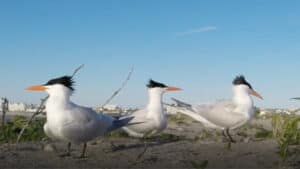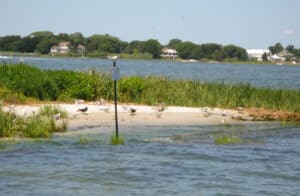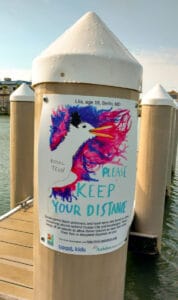Coastal Bays Islands; They’re For the Birds!
Creature Feature: Royal Tern

While out boating, or enjoying a walk along the bay, you may have seen a bird hover over the water, then quickly dive and emerge with a wiggly fish in its beak. Most likely, this was a royal tern, and they great fun to watch. Royal terns are found in most coastal areas and make extensive annual migrations from the mid-Atlantic to Central and South America. Maryland is around the northern extent of their breeding range, and unfortunately, these birds are in trouble.
Eggs are vulnerable
Since royal terns live along coastal areas, they have evolved a habit of laying their eggs in shallow depressions on bare sand between the high tide line and the coastal grasses. Their eggs are sand colored and the birds nest in large colonies which helps to keep predators away.
Beaches are their ideal nesting area, however, shoreline development has driven the birds to nest on isolated islands. But island

nesting can be treacherous. Storms with high water levels can wash away nests, and sea level rise and erosion have greatly reduced the number of islands in the coastal bays. In fact, almost 300 acres of our island habitat have been lost in the past 25 years.
Because of island loss, numbers of royal tern breeding pairs have dropped drastically over the years. Royal terns, and the other birds that nest on the ground on the islands such as common terns and black skimmers, are now listed as endangered in Maryland, and the coastal bays are the only place in Maryland these birds breed. So, the islands that still exist in our local bays are extremely important for these birds.
How you can help the royal tern

What you can do is please stay off the islands during the summer months. These birds should not be disturbed while they are nesting, and the public’s cooperation is of the utmost importance. Due to the quarantine, warning signs have not put out on the islands yet, so please be aware and keep your distance. Help us help the birds!
About the MCBP contributor
Dr. Roman Jesien is the Science Coordinator at the Maryland Coastal Bays Program. Since 2002, he has been the technical lead for science and restoration-related programs and projects throughout the coastal bays watershed.

